Industrial interior design celebrates the beauty of raw, unfinished materials, creating a look that’s edgy, authentic, and effortlessly chic. From exposed brick and metal pipes to concrete floors and reclaimed wood, raw materials are the foundation of this timeless style. By showcasing these elements, you can achieve a space that feels honest, functional, and full of character.
I remember my first industrial design project—a loft conversion that exposed brick walls hidden for decades. The moment we uncovered them, the entire space came alive with a sense of history and authenticity. Since then, I’ve learned that incorporating raw materials is not just about aesthetics but also about honoring the origins of the space.
In this guide, we’ll explore how to use raw materials effectively in industrial interior design, offering tips and inspiration for creating a space that’s bold, modern, and full of personality.
Why Raw Materials Are Essential in Industrial Design
1. Authenticity and Character
Raw materials bring a sense of history and authenticity to industrial interiors, reflecting the origins of factories and warehouses.
2. Textural Contrast
The rough, unfinished textures of raw materials create depth and interest, balancing the clean lines and minimalist aesthetic of industrial design.
3. Durability and Sustainability
Exposed materials like concrete, metal, and reclaimed wood are not only durable but also eco-friendly, often repurposed or reused.
Key Raw Materials in Industrial Design
1. Exposed Brick
- Why It Works: Exposed brick walls are iconic in industrial design, offering warmth, texture, and a connection to the building’s structure.
- How to Use:
- Leave brick walls untreated for a rustic look.
- Paint them white or gray to soften the aesthetic while retaining texture.
- Highlight them with track lighting or sconces for added drama.
Pro Tip: If your space doesn’t have brick walls, consider using brick veneer panels for an authentic look.
2. Concrete
- Why It Works: Concrete is sleek, durable, and versatile, embodying the utilitarian ethos of industrial design.
- How to Use:
- Use concrete for floors, countertops, or even walls.
- Opt for concrete planters, tabletops, or shelving for subtle accents.
- Pair concrete with warm materials like wood or leather to prevent the space from feeling too cold.
Pro Tip: Polish concrete surfaces for a modern finish or leave them raw for a more rugged look.
3. Metal
- Why It Works: Metals like steel, iron, and aluminum are staples of industrial design, reflecting the mechanical origins of the style.
- How to Use:
- Incorporate metal in furniture like tables, shelving, and chairs.
- Use black metal pipes for shelving or as a structural element.
- Add metal pendant lights, sconces, or hardware for small, impactful touches.
Pro Tip: Opt for matte or distressed finishes to maintain the raw, industrial vibe.
4. Reclaimed Wood
- Why It Works: Reclaimed or distressed wood adds warmth and a natural element to balance the harder materials in industrial spaces.
- How to Use:
- Use reclaimed wood for dining tables, coffee tables, or shelving.
- Incorporate wood panels for accent walls or headboards.
- Add wooden beams to ceilings for a striking architectural feature.
Pro Tip: Choose wood with visible grain, knots, or imperfections for a more authentic look.
5. Glass
- Why It Works: Glass adds a modern touch to industrial interiors, balancing the rough textures of brick, metal, and wood.
- How to Use:
- Use glass panels or partitions to create open spaces while maintaining privacy.
- Incorporate glass tabletops paired with metal frames for dining or coffee tables.
- Opt for industrial-style windows with black metal frames.
Pro Tip: Frosted or textured glass can soften the aesthetic while maintaining the industrial look.
6. Leather and Fabrics
- Why It Works: Leather and textiles add comfort and warmth to balance the raw materials in industrial interiors.
- How to Use:
- Choose distressed leather sofas, armchairs, or bar stools.
- Add linen or canvas cushions and throws in neutral tones.
- Use rugs with subtle patterns or textures to ground the space.
Pro Tip: Stick to earthy colors like brown, black, and tan for a cohesive palette.
Tips for Incorporating Raw Materials in Industrial Design
1. Highlight Architectural Features
- Showcase structural elements like exposed beams, pipes, or ducts to celebrate the building’s history.
- Avoid covering these features with paint or drywall; let their raw beauty shine.
2. Balance Raw and Polished Elements
- Pair raw materials with polished finishes like glass or metal for contrast.
- Use soft furnishings and warm lighting to offset the rugged textures.
3. Mix Materials
- Combine brick, metal, wood, and concrete for a layered, dynamic look.
- Avoid overloading the space with one material to maintain balance.
4. Keep the Color Palette Neutral
- Stick to neutral tones like gray, black, white, and brown to let the raw materials take center stage.
- Add pops of color sparingly, using artwork, plants, or textiles.
5. Use Sustainable Materials
- Opt for reclaimed or repurposed materials to reduce waste and create an eco-friendly design.
- Check out local salvage yards for unique, vintage finds.
Picture Gallery
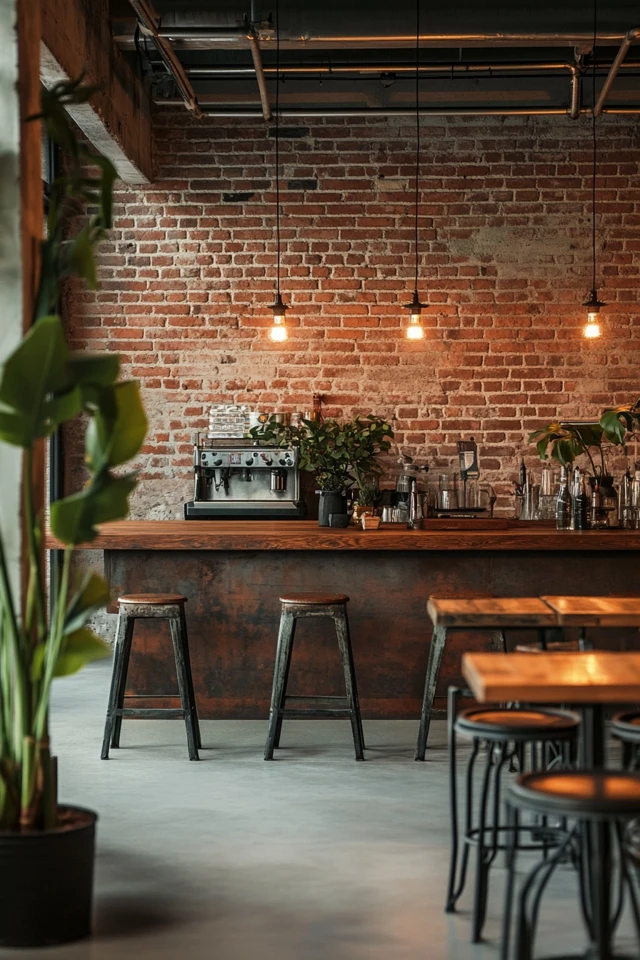
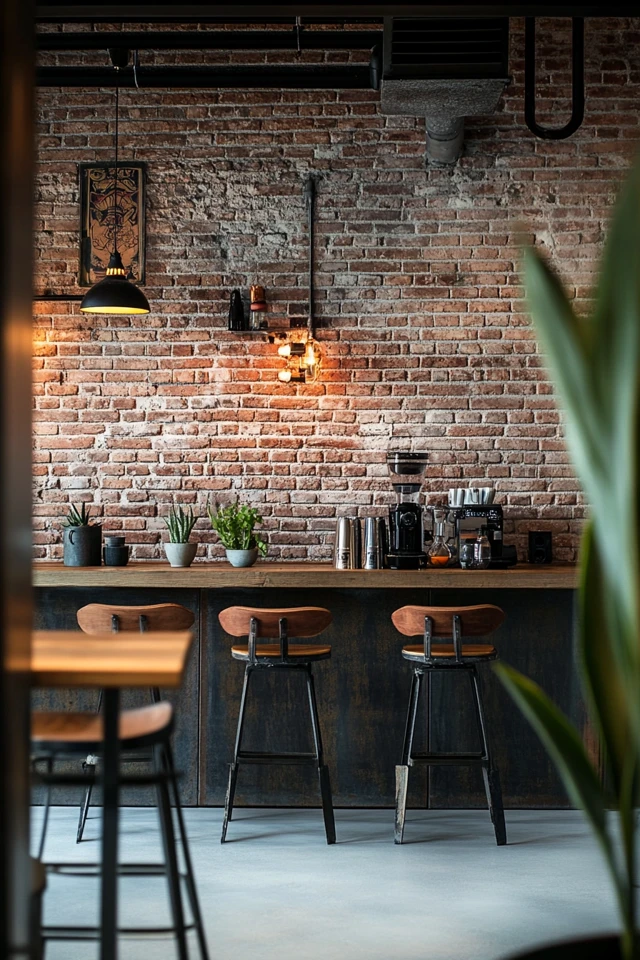
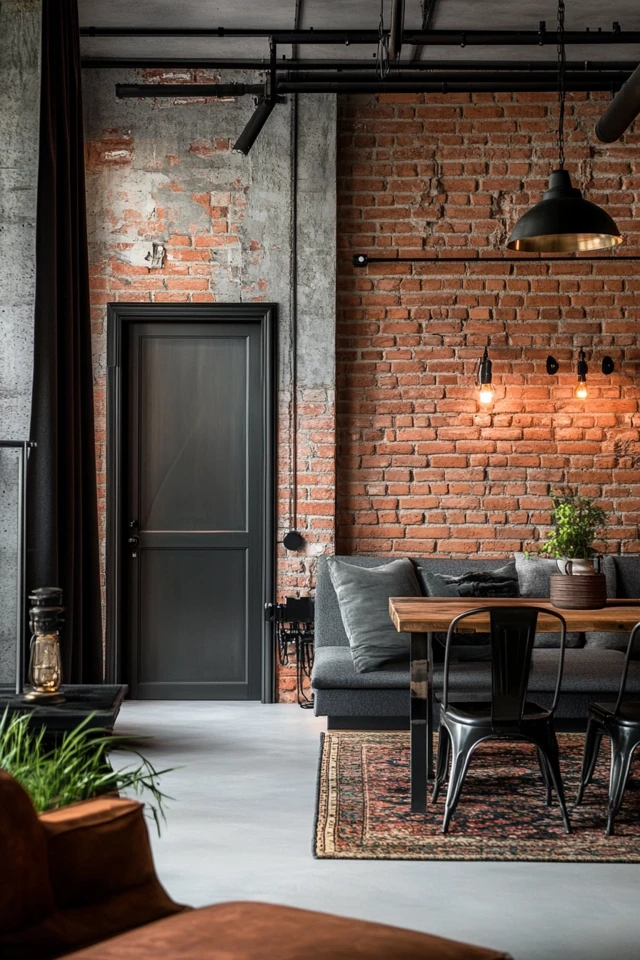
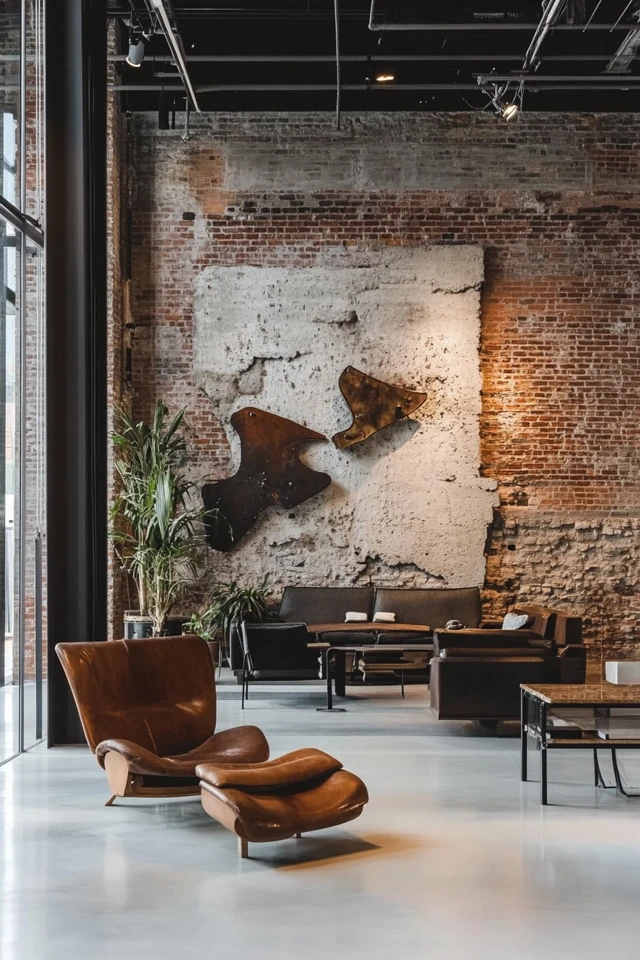

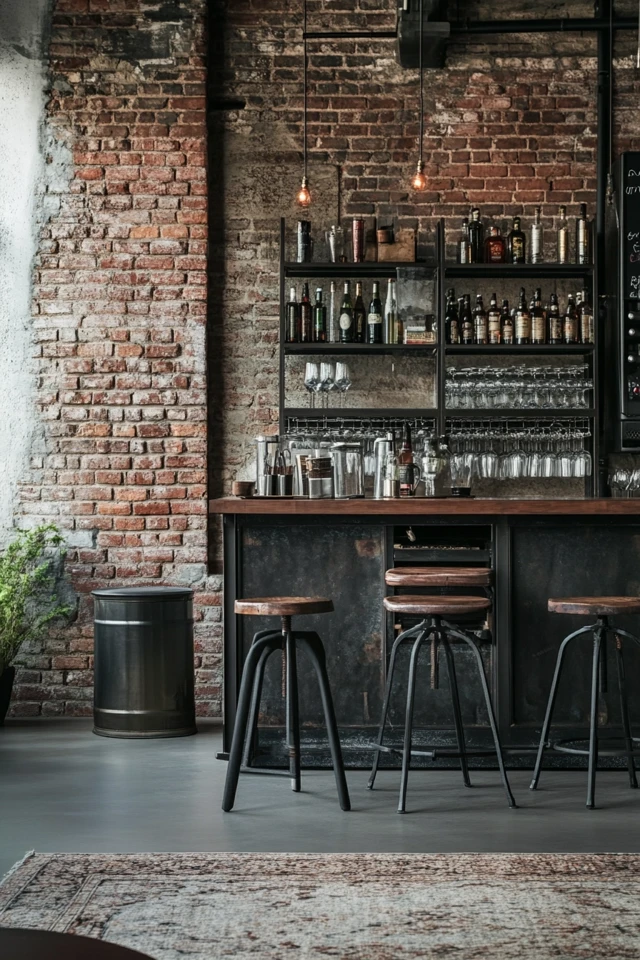
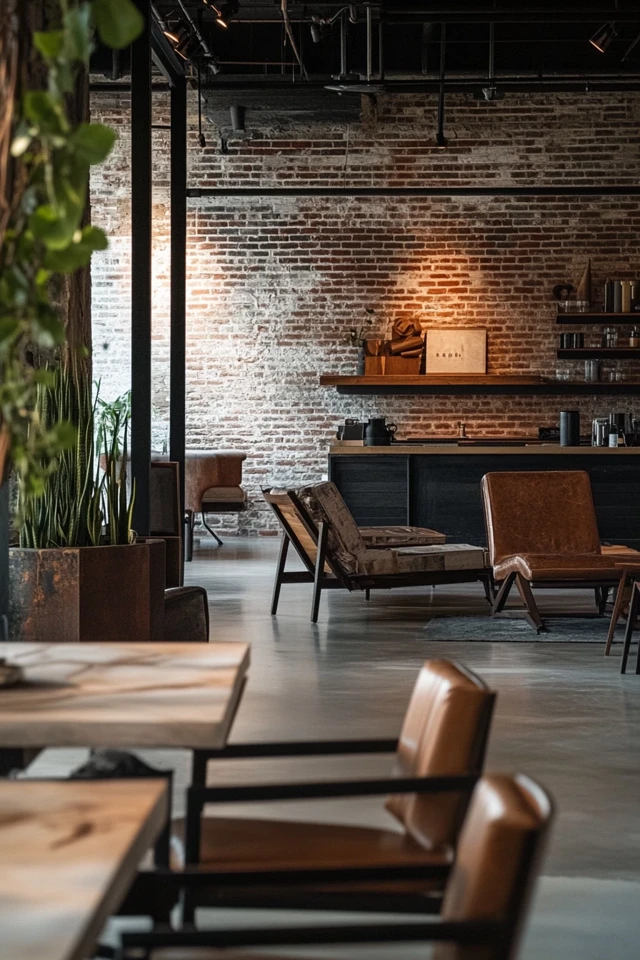
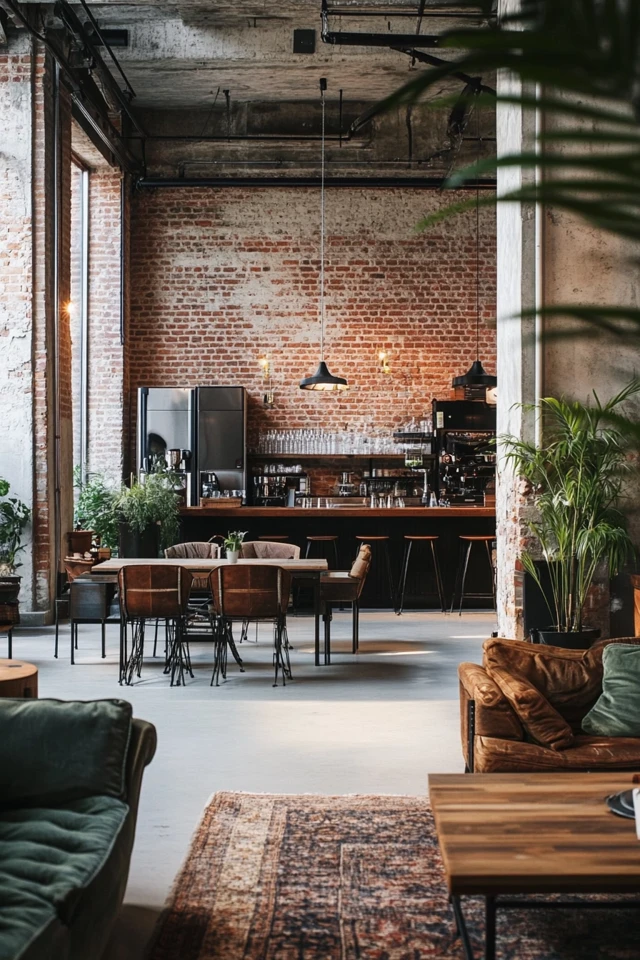
Styling Ideas for Raw Materials
1. Exposed Brick Wall in the Living Room
- Pair a brick wall with a leather sofa and a metal coffee table.
- Add industrial-style lighting, like Edison bulb pendants or sconces.
2. Concrete Floors in the Kitchen
- Balance the raw texture of concrete with wooden cabinetry and open metal shelving.
- Use a patterned rug to add warmth and interest.
3. Metal and Wood Shelving in the Bedroom
- Install black metal pipe shelves with reclaimed wood planks.
- Use them to display books, plants, and industrial décor accents.
4. Reclaimed Wood Dining Table
- Pair a rustic wood table with metal dining chairs or a bench.
- Add a centerpiece of industrial-style candlesticks or a simple vase with greenery.
5. Glass and Metal Partitions
- Use glass partitions with black metal frames to divide spaces without losing light.
- Incorporate textured or frosted glass for added privacy.
Conclusion
Raw materials are the backbone of industrial interior design, bringing authenticity, texture, and a sense of history to any space. By incorporating elements like exposed brick, reclaimed wood, and distressed metal, you can create a design that feels both edgy and inviting. Balance these materials with softer furnishings and warm lighting to ensure your space is comfortable as well as stylish.
Whether you’re designing a loft, a modern home, or a small apartment, raw materials will give your space a bold, industrial edge that stands the test of time. So go ahead—embrace the beauty of imperfection and let your interior tell its story.
FAQs
1. Can I use raw materials in small spaces?
Absolutely! Stick to lighter finishes and balance raw materials with polished elements to avoid overwhelming the space.
2. How do I maintain raw materials like brick and concrete?
Seal exposed brick and concrete surfaces to protect them from dust and wear. Clean with gentle, non-abrasive products.
3. Can raw materials be mixed with other design styles?
Yes! Raw materials pair well with modern, rustic, and even bohemian styles for a unique, layered look.
4. Are raw materials expensive to use in design?
While some raw materials like reclaimed wood can be pricey, others, like concrete, are cost-effective. Look for salvaged or repurposed options to save money.
5. Where can I find raw materials for my industrial design project?
Check local salvage yards, flea markets, or online marketplaces for reclaimed wood, metal, and vintage pieces. Many home improvement stores also offer raw material-inspired finishes.


